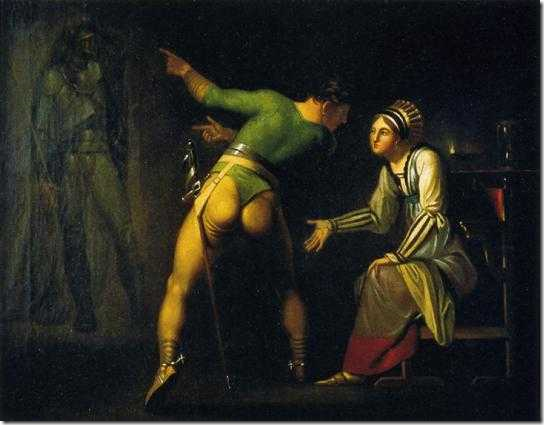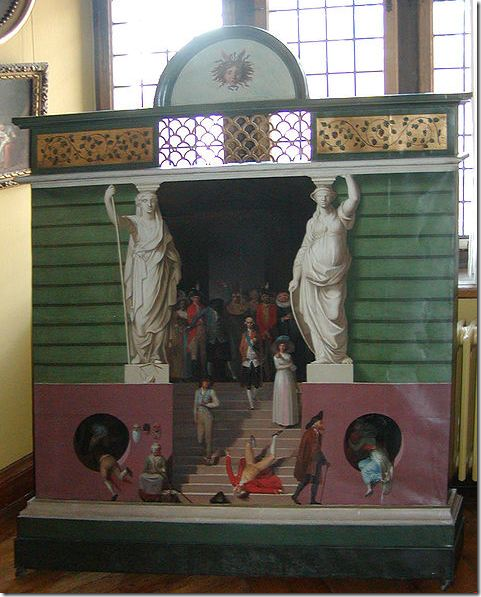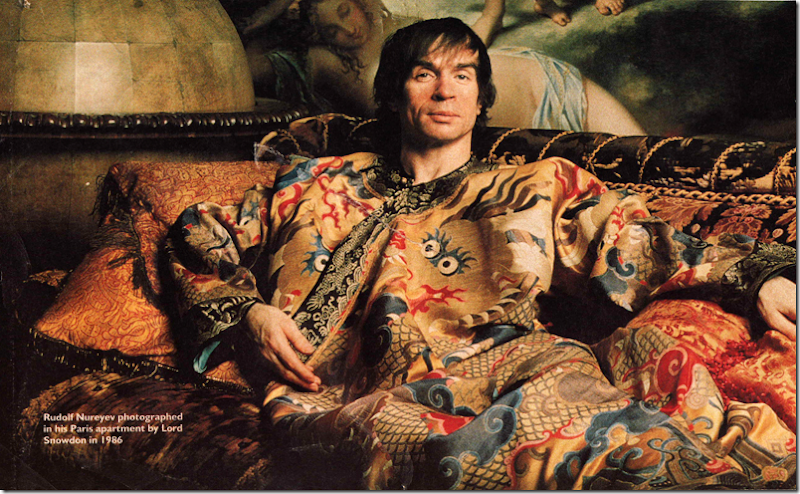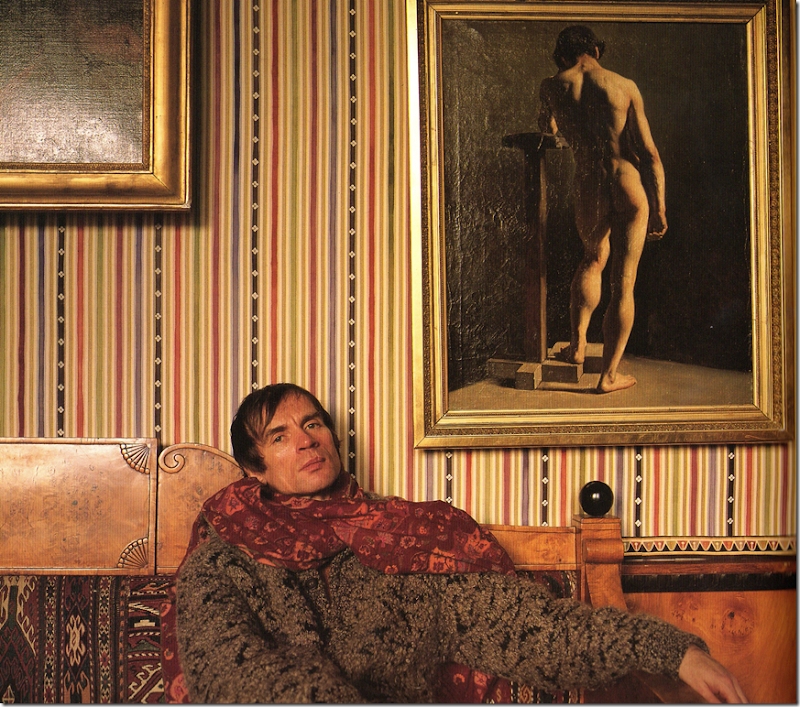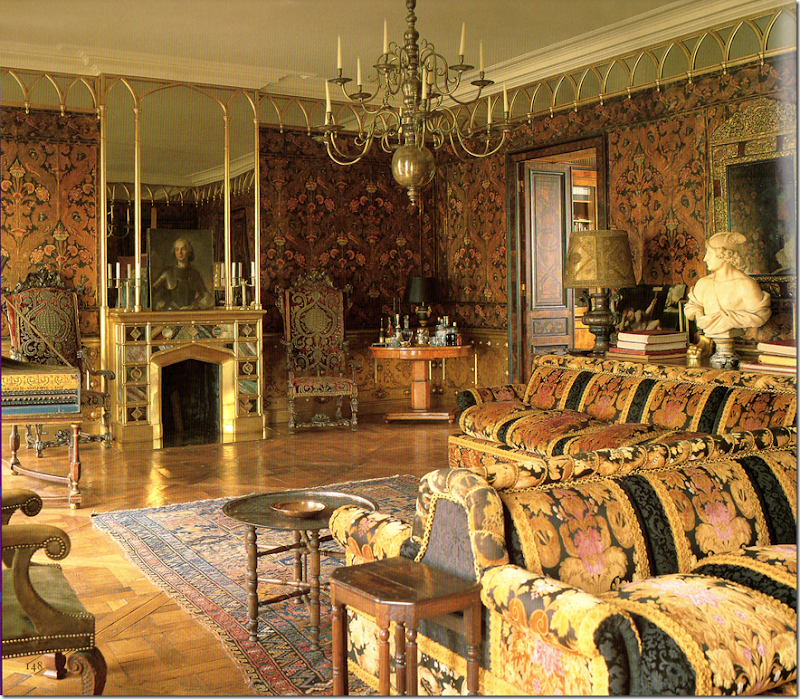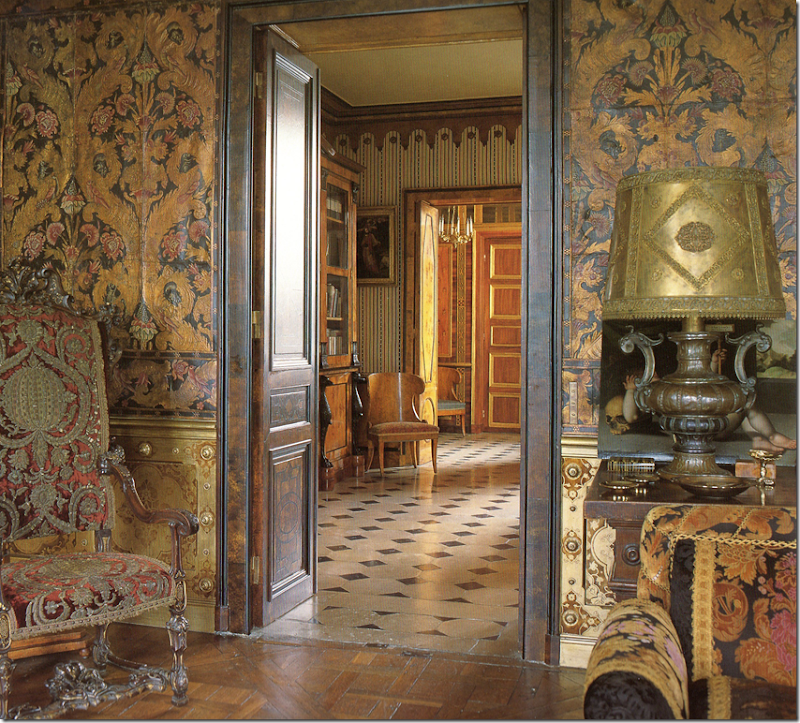In the latest Elle Décor magazine, this apartment caught my eye. I mean, who could miss seeing the huge painting of a nude male’s rather prominent backside? Why does it look somehow familiar? Certainly Mr. Slippersocks Man doesn’t look like THIS! I adore the interior designer, Alex Papachristidis. Alex P. is probably best known for his own apartment – a wonderful mix of patterns and colors:
Here is Alex P.’s apartment that I love so much. A mix of Fortuny, Ikat, and Suzani – what could be better? And look – another male’s backside!!!! Hmmm. Must be a new trend here.
Now, I’m no expert on art, but this painting looked familiar. Who could forget something like this? According to Elle Décor’s story, this large 19th century Italian painting was bought at Christie’s auction of the late Rudolf Nureyev’s Paris apartment. Nureyev was famous for this collection of nude male art, which lined the walls of his Parisian home. The owner of this London apartment is a 30s something woman who recently suffered a devastating divorce. Is this painting of a perfect male specimen the ultimate revenge?
A-Ha! David Easton’s apartment: here the painting pops up again. In his new book, Easton writes: “A copy of Philoctetes Bitten by a Snake hangs in the niche. (The actual name of the painting is The Wounded Philoctetes.) Easton continues, “I saw the original by Abildgaard in a Danish museum and fell in love with it. While traveling in Russia, I commissioned a restoration artist at the Hermitage to reproduce it.” This explains why there are two of this most famous painting hanging in two different apartments. One is a copy, painted expressly for David Easton. The other is an original, or is it?????
If the painting hanging in the English apartment featured in Elle Décor is original, why is it also hanging in the Statens Museum in Denmark? Hmmm????
That exact question was asked in this book on the artist of The Wounded Philoctetes, Nikolaj Abildgaard. Abildgaard’s widow owned the copy of the painting after his death. After she died, the painting went to the gardener of family friends. Apparently, the Forbes Collection once owned this mysterious copy (or is it?) and it was sold in an auction at Christie’s to the ballet star Rudolf Nureyev. When Christie’s was approached about this being a possible fake, the attribute was changed to say the painting was “a version of the picture in the Statens Museum.” The author of this book tells about contacting Christie’s and informing them how “precarious” the provenance was, leading to it being called a “student copy.” (For more information about student art and copies of works – see the end of this story.) The book is written in Danish, so it is hard to truly understand what is being said about this copy of The Wounded Philoctetes. The issue may be that Abildgaard was a famous art teacher and there is some question whether a student painted the American version or did Abildgaard paint both? The answer seems murky at best. At one point in time, even the United States planned to exhibit the American Philoctetes – saying it was an original. I used the Google translator to read these passages, but Google translations are sketchy at best. Still, I would love to read the book in English to truly understand how this “copy” landed on the market and if the Forbes Collection and Nureyev truly believed they owned an original Abildgaard. The painting in question is important to the art world as it is the first from Denmark to be internationally recognized.
A portion of the painting was used on the cover of Mary Shelley’s Frankenstein for the Penguin Classics printing.
The artist, Nikolaj Abraham Abildgaard (September 11, 1743 – June 4, 1809), was born in Copenhagen and studied art under the masters of his time. He was awarded medals that allowed him the funds to travel to Europe to study and paint. He chose to go to Rome and it is there that he painted his masterpiece, The Wounded Philoctetes, after being influenced by the works of Rafael, Titian and Michelangelo, amongst others. It was in Rome when he moved away from classical romantic painting to mythology. Back in Denmark, he taught painting, mythology and anatomy. Besides painting, he was also known as an architect and sculptor. The Royal family hired him to modernize a palace after their own was burned. Many of his interiors remain today at Christian VIII’s Palace in Denmark. The fire was also unkind to the painter – eight of his large canvases burned along with palace.
Abildgaard was interested in Shakespeare and here he painted Hamlet. Yes, his interest in male anatomy is rather pronounced in this painting.
He was also fascinated with the bible, here painting the Archangel Michael and Satan over the body of Moses. Satan also has well rounded buttocks – who knew????
Adrastus Slaying Himself at the Tomb of Atys. This was painted in Rome at the same time as The Wounded Philoctetes. Here, his attention was finally directed to the front of the male. And this was before health clubs and weight machines!!!
“Jupiter Weighs The Fate of Mankind”
Abildgaard was highly intelligent and was learned in many different subjects. He was considered a free thinker who was repulsed by the idea of slavery and excited by the politics of the day and the French revolution. The Royal Family was not pleased with his ideas. He had been commissioned to paint many large canvases for the Royals, but when presented Jupiter Weighs The Fate of Mankind, the Royals had had enough and he was isolated, censored and never received another official commission. I am not exactly sure why this painting so insulted the Royal Family, though it is an awfully ugly painting, IMHO!!
After he was censored for his political and religious views, he began work as an architect and furniture maker. His interiors are still in use in Christian VIII’s Palace in Copenhagen. Here, he designed the furniture, the ceiling and the overdoors.
A beautiful Klismos chair that Abildgaard made – it is in the Statens Museum.
The artist constructed and painted this cabinet for the Royal Family.
At the turn of the century, the artist returned to painting and was even again received by the Royal family. He married a second time and had several children before his death in 1809. It all seems somewhat strange that a rather obscure painter’s most important work of art would turn up in Elle Décor this month and also in Timeless Elegance, David Easton’s book released last month. Small world, as they say.
So, who, you might ask, exactly is this famous Philoctetes? He was an mythical archer who was sent off to the battle of Troy where he was bitten by a snake. The wound on his foot became infected and developed a terrible stench. Without medicine, all he could do was scream in agony, causing the other soldiers to abandon him on an island and sail off without him. Although he appears in Abildgaard’s painting to be a Hercules, he actually depicts the power of physical pain, not physical power. Art critics note that with this painting, Abildgaard overcame the difficulties of illustrating “pain.” Here, the artist does not bring attention to the hurt, putrid and bandaged foot. In fact, there are no bandages painted. Instead, he paints pain as shown through the convulsion of his body. Philocetes is bent over – his spine makes a quarter circle, while the “right thigh, buttock, torso, shoulder and arm look like a clenched fist.” His body is portrayed as if he is wracked in pain, tightly painted into the confines of the canvas. Painted while in Rome, Abildgaard’s style changed once he returned home. The artist is not considered the father of Danish painting, that title goes to C.W. Eckersberg. Yet, Abildgaard was Eckersberg’s professor and is sometimes called the Grandfather of Danish painting.
Rudolf Nureyev in his Paris Apartment – surrounded by the textiles and paintings he so loved. (Balustrade and Bitters HERE.)
The painting The Wounded Philoctetes shown in this month’s Elle Décor was purchased at Christie’s Nureyev estate sale. On Christie’s web site, there is no mention of the painting by name, but most likely it is one listed as a “study of…” since the provenance can’t be authenticated. The original painting hangs in the Statens Museum in Denmark. Christie’s held several sales, one of Nureyev’s New York Dakota apartment and another in London of his Paris apartment. His NYC apartment was not considered a home and was used more like a hotel, but the Paris apartment was a much beloved place in Nureyev’s heart. The walls were filled with paintings – mostly of male nudes. One can imagine how well the Philoctetes fit in. Nureyev was born into abject poverty on a train in Siberia. He lived with his family and two sisters and two other families in a one room house. From such humble beginnings, he became the most celebrated and talented male ballet dancer. He was cautious about his wealth, preferring to put his money into goods instead of banks. Thus his apartments were filled with art, antiques, and fine furniture. He was considered a genius and was well read – his library was stacked with books about his art, his rugs, and his textiles. His closets were filled with oriental robes, obis, costumes, and shawls. The Paris apartment was decorated with his many accessories and artifacts. His cabinets held numerous dinner services and cutlery. And everywhere, there was art. The nudes were too numerous to hang – some were stacked behind sofas and under the beds. Not all the paintings were fine – many were amateurish – called student’s work. Some say the nudes reflect his love of the male physique, since his own body was a well honed machine. Others contend the nudes were purchased for their homo eroticism. Yet, the Philoctetes is a study of a man in utter pain – not erotic pleasure. Nureyev’s indiscriminate sexual appetite was well known. He had multiple partners and only a very few long lasting affairs. Regardless of how he led his private life, he was such an elegant man, swathed in his robes and shawls, his head often wrapped in scarves, his appearance was every bit as visually stimulating as his art work.
Here in pictures taken by Derry Moore for his book, Rooms, the dancer is shown in his beautiful Paris apartment. The nudes line the walls, sometimes reaching up three to the ceiling. How gorgeous is this robe he wears here? It looks like a silk ikat. Emilio Carcano helped Nureyev decorate the apartment, which was photographed by Moore for Architectural Digest in 1985.
In the book, Rooms, Moore implies that Nureyev was sick and sweaty with a cold or maybe AIDS when this picture was taken, yet this was ten years before his death. Nureyev hid his disease and denied he was ill until the very end. He spent most of that time in his Paris apartment and at his hideaway island on the Italian Amalfi coast.
In the living room, the walls are covered in a tooled Spanish leather. Notice the harpsichord on the very left. Unfortunately, the painting in question is not visible in any of these pictures. This room has two fireplaces facing each other and a large double sided sofa sits in the center of the room.
Looking from the living room into the study/library. Here you can see the leather walls up close.
A view from the living room towards the second fireplace. Those doors! Those floors!
The bathroom with its copper tub. The room is lit by a faux skylight. Now THAT’s a faucet!!!! What an amazing piece of hardware. The marble floors found in the library flow here into the bathroom – the height of luxury.
It’s only fair!!!! After showing off so many bums, it’s only fair we get to see Nureyev’s own backside – proudly displayed on vacation at his Italian island. There are a series of nude photographs taken by Avedon in 1961 during Nureyev’s youth, when he was at his peak physically. A simple google search reveals all, leaving nothing to the imagination.
Nureyev was buried in Paris. His grave is quite unusual and beautiful – just as the man himself was. Covered in a mosaic rug, it symbolizes his great love of art, textiles and rugs in particular. How amazing is this???? When I first saw pictures of his grave, I thought perhaps someone had temporarily thrown a rug over it. I wonder what it looks like in person, if it is easy to tell it is not a real rug? In pictures, it absolutely looks like a rug.
A close up of the mosaic rug – here you can see the actual tiny pieces that create the illusion. Rudolf Nureyev died in 1995.
For those interested:
In this short part of a longer article, HERE, the author explains teaching school art and why it is so hard to attribute some paintings to the true artist.
The term academies was first applied in the 17th century to drawings and paintings made from live models - male, of course. But it was the 19th century that saw the real flowering of the genre. At the beginning of the 18th century there were only 19 art schools or academies in all Europe; by the beginning of the 19th there were 200, and by its end some 2,000.
Every pupil, in every academy, was required to make figure studies. Vast numbers of them were made. Though many were destroyed or painted over, there are still very large numbers around. Until about 10 years ago, they were considered unsaleable; it was then that dealers, noting an expanding interest in the 19th century generally, started cleaning them off and putting them back in their shops.
It was the French, with their love of method and order, who formalised the 19th-century system of teaching art; imitated all over the world, it has come to be dismissed in our century as "academic". But the students at the Paris Academie des Beaux-Arts, through long and wearisome hours of drawing casts of classical sculpture and live models (often their teachers), achieved a technical mastery that is never likely to be repeated. It can be admired in all its glory in the Nureyev collection, which concentrates largely on this school and period.
A nude by Theodore Gericault, the short-lived genius of French romanticism, is the earliest example in Nureyev's collection. "He loved Gericault," says Francois, "and bought his first one in Paris from a dealer called Lebel - he was not even thinking of collecting academies at the time." Gericault, who died at the age of 35, left only one major painting, The Raft of the Medusa (now in the Louvre) but his many admirers ardently collect his sketches and studies. The Nureyev sale contains four, plus one "attributed to Gericault" and two more catalogued as by "followers of" Gericault.
*********************************************************************************************************************************
Finally,
In other magazine news, this month’s The World of Interiors has an article on Nancy Lancaster’s famous buttah-yellow drawing room. Celebrating the room’s 50th anniversary, Colefax and Fowler has recreated the room, using some original elements and some major new elements. At first glance, I was stumped at the cover. I knew what it was, but it wasn’t what I knew! The chandeliers leap out as a major difference in the new version. So do the back mirrors. The article is a fascinating and fun read if you are into Lancaster and her most well known room – in fact, some think of this as one of the most famous rooms in interior design. Before you read the article – try to guess how many elements are different and how many are the same. That is, if you have all the time in the world.
The original room – spot the differences?
And don’t forget the new Skirted Roundtable is up with Belgian Pearls’ Greet, HERE.




![P1180429_thumb[1] P1180429_thumb[1]](http://lh3.ggpht.com/_t8-Y4w1UKrc/TObzpJeszUI/AAAAAAAA768/Ub8TK5X7yUI/P1180429_thumb1_thumb.jpg?imgmax=800)




